SHIFTING RESPONSIBILITY
A COMMUNITY-BASED APPROACH TO WILDFIRE OUTBREAK PREVENTION
BY ROSA DIEMONT AND TIEME WANDERS
Forests in Ghana are increasingly being influenced by human-induced fires. Until the 1980s, uncontrolled wildfires were relatively uncommon in Ghana, especially in the forest zone in the southern regions of the country.
When talking to the older farmers, many recall 1983 as a tipping point. In that extremely dry year, the country experienced devastating wildfires that destroyed forests, villages and even people’s lives. Ever since, wildfires have been an annual phenomenon in Ghana’s landscapes, and decision makers have been puzzling over how to keep Ghana safe during the dry season.
A community-based approach reduced wildfires outbreaks by 78 per cent between 2018 and 2021. From a situation in which wildfires were frequent annual occurrences that nobody could stop, for which no one felt responsible, and from which everyone suffered, change has occurred to a situation in which people feel responsible for managing the fire risk and are able to prevent wildfire outbreaks.
In 2017, Form International and Form Ghana developed the Forest Landscape Restoration Program for Tain II Forest Reserve. Form Ghana is a forest plantation management company based in central Ghana that produces timber and carbon credits for local and international markets. One of Form Ghana’s concessions is located within Tain II Forest Reserve in the Bono Region in Ghana. The donor-funded Forest Landscape Restoration Programme was set up to collaborate with the neighbouring farmer community to develop improved livelihood activities in the Tain II Forest Reserve.
The land of the neighbouring community is mostly customary land under the traditional authority of chiefs and their families. The area around Tain II Forest Reserve is a rural area and most people living around it are subsistence or smallholder farmers. Most people rely only on farming as their sole source of income.
The Tain II Forest Reserve lies within the Eastern Guinean lowland forest zone, a dry semi-deciduous forest type. The Forest Reserve was once completely covered with this forest type and played a vital role in the lives of people living near it. Today however, very little of the original forest remains and vast areas of the reserve are covered with savannah-like farm bush, resulting from human-induced degradation. Intensive farming and annually occurring wildfires promoted the growth of elephant grass (Cenchrus purpureus), a tall and fast-growing tropical grass species that prohibits natural regeneration of forest and makes a high, very dry and flammable fuel load during the dry season.
The removal of the trees, in combination with the environmental conditions and poor infrastructure of the area, worsens the situation. During the dry season (from December until March), the humidity drops below 10 per cent during midday. The Harmattan winds dry out the vegetation and dust in the air can severely limit visibility. The poor road network prohibits rapid response to fires and remote areas are difficult to reach. All elements that can contribute to severe uncontrollable fires are thus combined. The frequent fires further degrade the already degraded, unmanaged areas within and around the Tain II Forest Reserve.
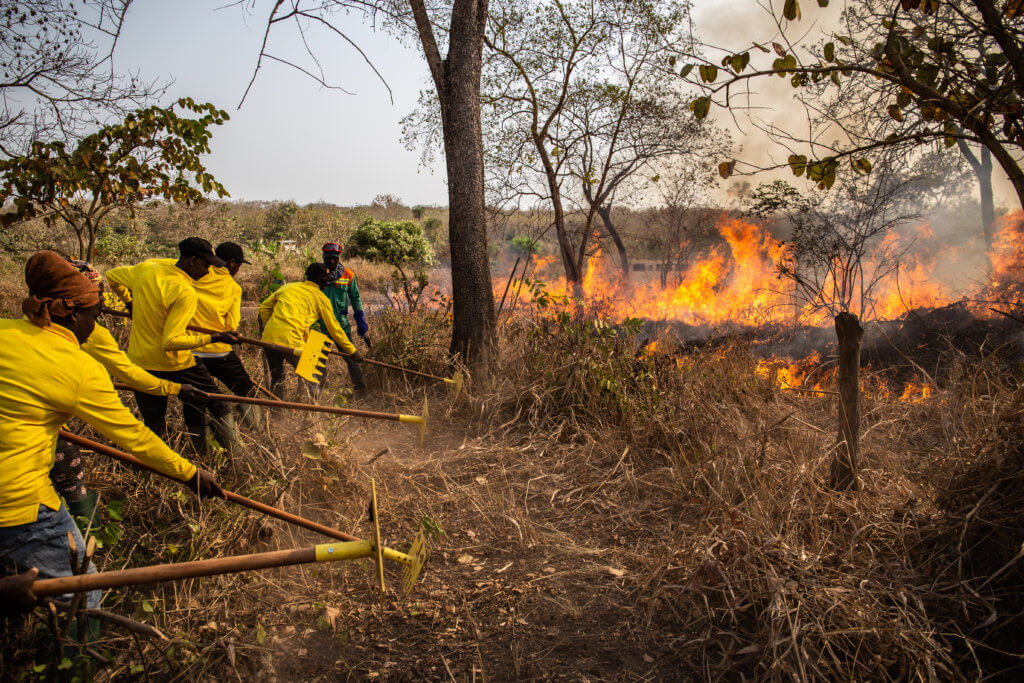
Photo by Melle Meivogel.
A TABOO ON THE USE OF FIRE AS A TOOL
In this zone of Ghana, fire is not a natural phenomenon; it is almost always human-induced. And the wildfires that run through the Forest Reserve annually do not come from within the Forest Reserve; they come from the communities around it. In Ghana, the use of fire as a tool is a longstanding practice: it is used in agriculture by farmers as a cheap way to clear a piece of land for cultivation, but also by other groups, such as hunters, herdsmen, and beekeepers. These groups are often blamed for the fire outbreaks. In addition, it is often mentioned that farmers have limited knowledge of fire management and therefore cannot manage farming-related fires properly. This is why the bylaws of many Ghanaian districts prohibit the use of fire during the dry season, making a traditional practice taboo. Ironically, the outlawing of burning does not have the desired result. Throughout Ghana, fires keep getting out of control, threatening farms, properties and lives. And, as a side effect, these occurrences of out-of-control fires strips farmers of control over their situations. Even worse, the situation creates conflict between farmers and other occupational groups, who blame each other for setting fire to avoid punishment.
A major consequence of the many wildfire outbreaks is that farmers became demotivated and discouraged from investing in perennial crops such as fruit and nut trees. When an area burns every year, farmers will plant only annual crops and to harvest before the dry season. As a consequence, the farmlands are left unmanaged after the harvest, giving way for wildfires to run freely through the landscape. This is a situation that farmers are very unhappy with but cannot change individually.
A GRASSROOTS-LEVEL SOLUTION FOR A LANDSCAPE-LEVEL CHALLENGE
While working together with key stakeholders such as the traditional authorities, the fire service, and the Forestry Commission Ghana on the implementation of the Forest Landscape Restoration Programme, the project team soon realised that outlawing burning in the dry season was not the way forward. One cannot tell farmers to stop using fire, because it is part of a way of life. To counter the accelerating degradation and to stimulate forest restoration, the incidence of fire in the area had to decrease, by drastically changing the roles of people in wildfire management.
Since the Control and Prevention of Bushfires Act came into practice in 1990, the regional fire offices in Ghana have operated through a system of community fire volunteers. The volunteers are responsible to execute daily patrols during the dry season, and they have the right to arrest offenders and report them to the police. Unfortunately, Ghana National Fire Service does not have the means to organise annual education programs or assist the fire volunteers with their organisation, the execution of pre-fire season prevention programs, or with the fighting of wildfires. All the responsibility for mobilisation, organisation and fire fighting has been left completely to the volunteers.
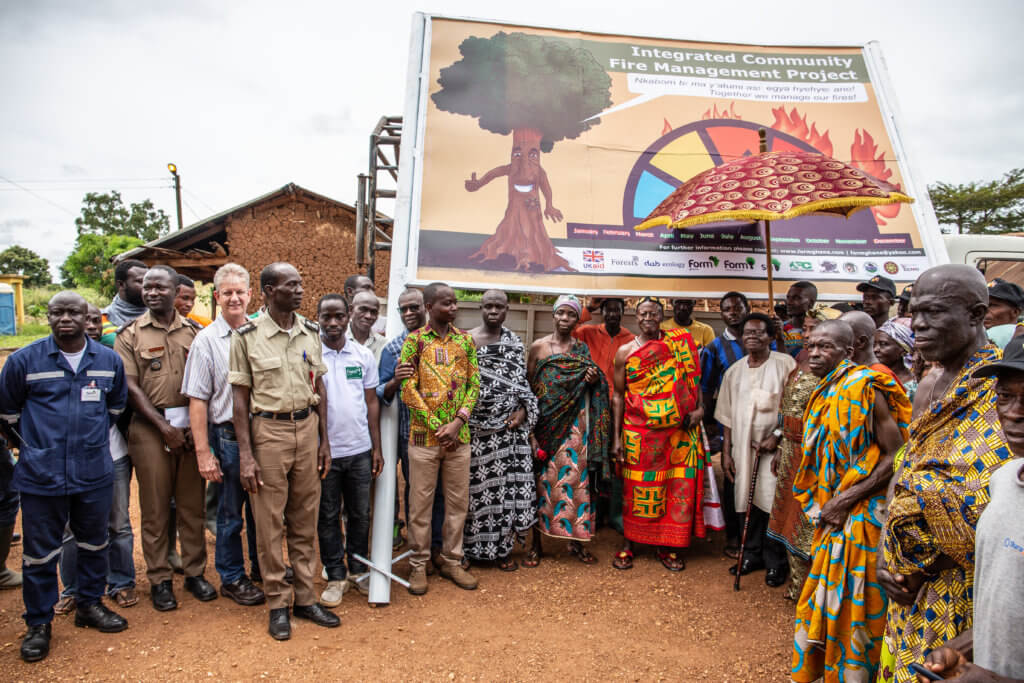
Photo by Rosa Diemont.
The project team found that traditional leaders were mostly left out of fire-related decision-making processes. The Ghana National Fire Service is responsible for fire management and the appointment of community fire volunteers. In this set-up, traditional leaders, who in Ghana are the stewards of the land, were not involved with the appointment and operations of the community fire volunteer squads. This resulted in conflict of interests and therefore friction and unproductive fire volunteer squads at village level.
As such, the first step of the program was the engagement with the traditional authorities and community leaders. Together with them, the fire service and the community fire volunteers, an Integrated Community Fire Management Project was developed. The proposed structural changes were endorsed by all. One of the largest structural changes was the revision of the local fire bylaws. The revised bylaw now states that farmers can be allowed to use fire as a farming tool, also in the dry season. The condition to this is that a community must be under a supportive program and has operational, trained and equipped community fire volunteers who work according to a set of operating procedures.
This caused a great change in how everybody perceives fire. Instead of fire being taboo and focusing on punishment for using it, the project could now focus on making people capable and responsible for taking preventive measures to reduce the fire risk and to use fire responsibly.
IMPROVED OPERATIONAL STRUCTURE
Together with all stakeholders, an improved operational structure was developed by dusting off good traditional working practices and adding new ones, such as the use of the Fire Danger Index, and allowing controlled burns that are regulated through a permission system.
In each squad, a leader and a leader-assistant were appointed who made a community fire management plan for the community. In this plan, community activities to limit fire outbreaks are formulated for the coming dry season. The squad leaders then present this plan to the village chief. The chief has to formally agree with this management plan as a sign of support and to give the mandate to the squad leaders to call people to action. The leaders are responsible for mobilising the fire volunteer squad and to train them. The squad leaders also mobilise farmers to prepare farms before the dry season and to undertake other collective actions such as the weeding of fire breaks as presented in the community fire management plan.
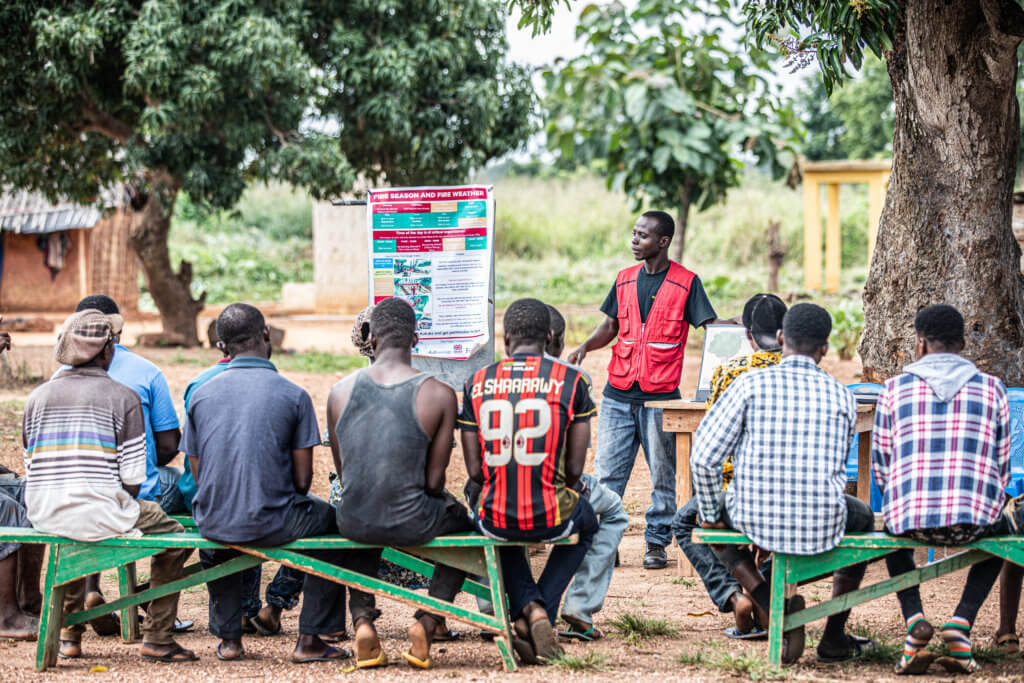
Photo by Melle Meivogel
The squad leaders were trained, and they in turn trained the entire volunteer squad and community members, on topics such as being fire wise, and the consequences of the use of fire. Key to the training was raising awareness in the communities on the new rules and regulation system and the permission system to do controlled burns. In the new system, the fire squad can give permission to farmers to burn their land based on whether it is safe according to the Fire Danger Index. The Fire Danger Index is adapted to the Ghanaian environment and is called Egya Kɔkɔbɔ in Twi, the language mostly spoken in the area.
Through a WhatsApp communication group, the Fire Danger Index and weather conditions are communicated on a two-hour basis to the leaders of the squads by the Form Ghana’s operations centre. In turn, the leaders communicate the FDI to the community using the fire notice signboard and the community’s central broadcasting system. This way, the whole community is kept aware of the climatic circumstances, how these affect fire behaviour and the fire risk. When the farmer is granted permission to burn his field, the fire volunteer squad provides assistance to keep it a controlled burn.
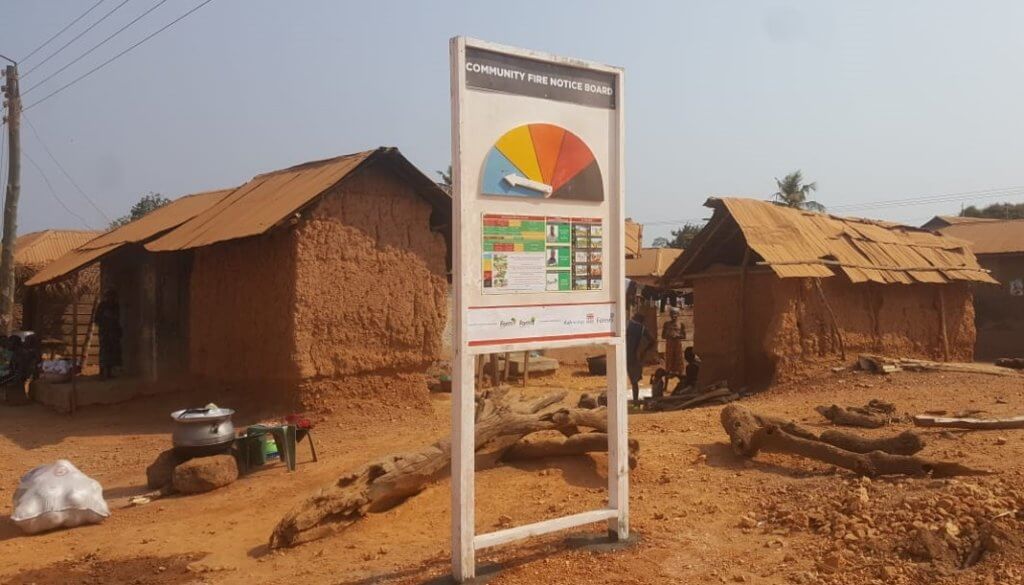
Photo by Rosa Diemont.
PREVENTION INSTEAD OF SUPPRESSION
In Ghana, there is no high-tech firefighting equipment available for suppressing wildland fires in rural areas. The road network is also poor in many areas, which prohibits the use of large firefighting vehicles. Fire volunteers were trained to suppress small to medium-size wildfires with hand tools, such as beaters and rake-hoes. As water is scarce in the dry season, fire squads could not be made water-dependent to suppress fires. For these reasons, the whole project is focussed on prevention instead of suppression.
As mentioned, the squad leaders are responsible for developing a Community Fire Management Plan for their villages and surrounding farm areas. These plans are completely focussed on preventing fire outbreaks and limiting the spread in case a fire gets out of hand. Based upon these plans, the squads and farmers undertake the planned preventative measures, such as the creation of strategically located fire belts to protect the villages and the farms, clearing and widening roads so that they serve as fire breaks, and making fire breaks around farms and other community properties. Some community fire squads join up to do large early block burns in the vast unmanaged areas around the Forest Reserve to establish low fuel load zones or a large defensive fire break to protect several villages.
RESULTS
After four years of implementing the Community Fire Management Project, the area under community fire management is 6,150 hectares. This land surrounds 8,072 hectares of Forest Reserve. The indirect result is that part of the Forest Reserve is protected by this shield of community fire operations. The number of wildfires in the community area reduced by 78 per cent compared to the baseline year of 2018. The fire frequency maps show this reduction. The darker the colour of a compartment, the more uncontrolled fires occurred in the dry season: the 2018 map shows the fire outbreak frequency before the project started and representative for the normal situation. The other maps show the improved situations in 2019, 2020, and 2021.
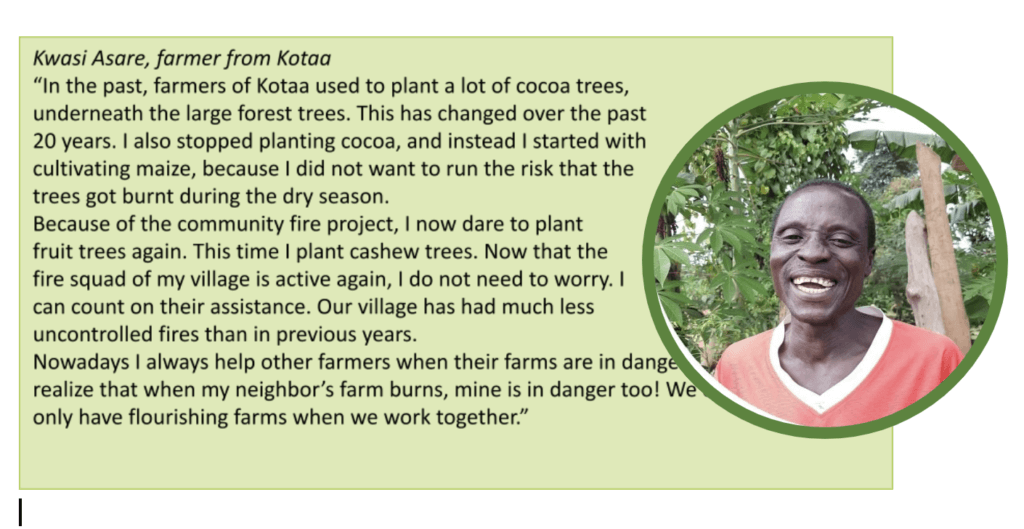
The community has taken back control over the use of fire. With the renewed skills and strengthened organisation, people are in control again. This control gives the community members confidence and new opportunities in farming as well. One result of the community fire project is that farmers have started developing agroforestry farms and tree-based farms, such as cashew and mango farms, intercropped with subsistence annual or perennial crops. About 3,000 farmers who have their farms in an area of 6,150 hectares experienced the change in the landscape. The fruit and nut cash-trees that were planted during the project’s period will provide additional income within four to five years. A positive side effect for the Forest Reserve is that the buffer zone around it is now under permanent farm management, as farmers now feel that it is worth the effort to protect the farms during the dry season.
Form Ghana sees that the robust company fire management organisation in the plantation is complemented with these community efforts. The strong and trusting relationship with the communities has been strengthened, further embedding the forestry company in the landscape. The renewed control over fire is a co-creation of the communities and the company.
The previously vast unmanaged areas of farm bush, dominated by elephant grass, are turned into diverse, productive and healthy farms with increased tree-cover and perennial crops. Farmers say it is now feasible to protect farms from fire in these areas. The well-functioning community system makes possible what in the past was not worth the risk. In fire-prone areas, community fire management is a critical base for joint landscape restoration initiatives that wish to stimulate tree planting, nature conservation and development of agroforestry farms.
The most significant impact has been that people took back responsibility and control. In principle, all land users have wildfires as a common enemy. Whereas prior to the program community fire volunteers felt powerless, they are now proud and confident, feeling part of the solution to protect the lives and livelihoods of their neighbours. People now know that they are capable of making a large impact on a large scale.
ABOUT THE AUTHORS
Rosa Diemont is managing the Landscape Restoration Programme for Tain II Forest Reserve. Under this program, she developed and implemented the Community Fire Management Project together with Form Ghana Ltd. and CMO. CMO delivered fire management consultation for this project.
Tieme Wander is senior forestry expert specializing in reforestation and forest certification. He has been responsible for several forestry research and development programs throughout Africa.
The Integrated Community Fire Management project is part of the Landscape Restoration Programme for the Tain II Forest Reserve, which was funded by DOB Ecology and DFID’s Partnerships for Forests programme. [RD1]
